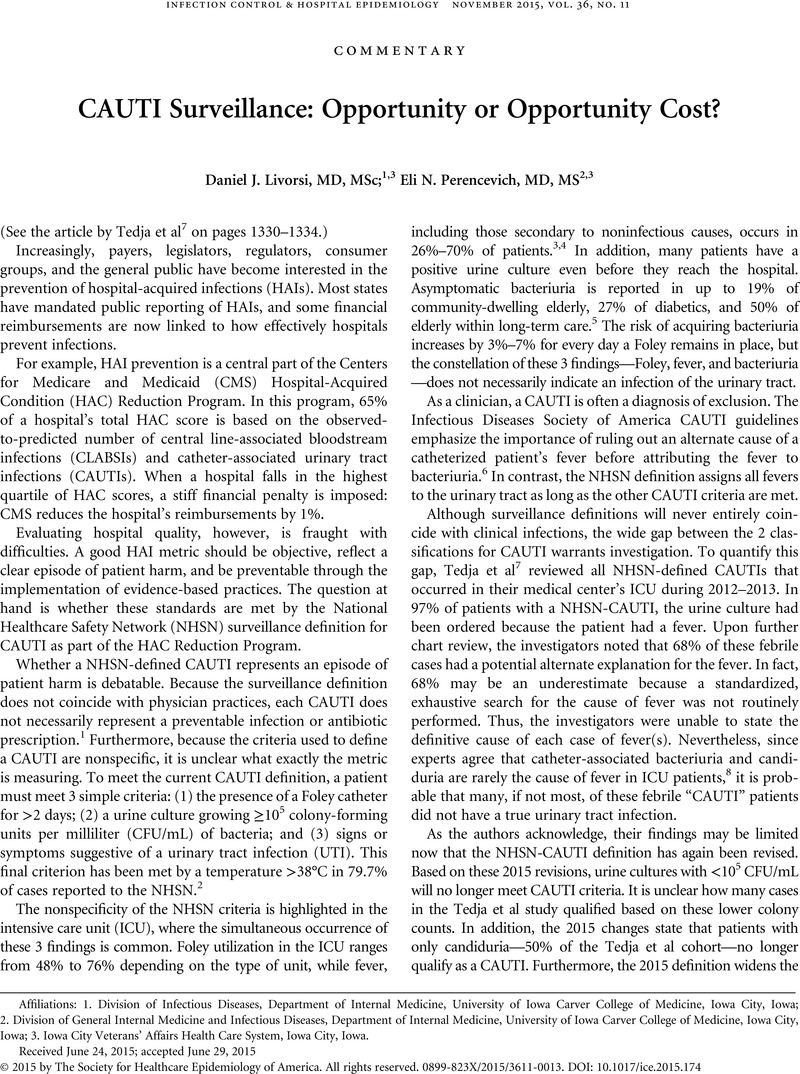Crossref Citations
This article has been cited by the following publications. This list is generated based on data provided by Crossref.
Clifford, Robert
Sparks, Michael
Hosford, Eve
Ong, Ana
Richesson, Douglas
Fraser, Susan
Kwak, Yoon
Miller, Sonia
Julius, Michael
McGann, Patrick
Lesho, Emil
and
Nychas, George-John
2016.
Correlating Cleaning Thoroughness with Effectiveness and Briefly Intervening to Affect Cleaning Outcomes: How Clean Is Cleaned?.
PLOS ONE,
Vol. 11,
Issue. 5,
p.
e0155779.
Garcia, Robert
and
Spitzer, Eric D.
2017.
Promoting appropriate urine culture management to improve health care outcomes and the accuracy of catheter-associated urinary tract infections.
American Journal of Infection Control,
Vol. 45,
Issue. 10,
p.
1143.
Advani, Sonali D.
and
Fakih, Mohamad G.
2019.
The evolution of catheter-associated urinary tract infection (CAUTI): Is it time for more inclusive metrics?.
Infection Control & Hospital Epidemiology,
Vol. 40,
Issue. 6,
p.
681.
Advani, Sonali D
Gao, Catherine A
Datta, Rupak
Sann, Lawrence
Smith, Cindy
Leapman, Michael S
Hittelman, Adam B
Sabetta, James
Dembry, Louise-Marie
Martinello, Richard A
and
Juthani-Mehta, Manisha
2019.
Knowledge and Practices of Physicians and Nurses Related to Urine Cultures in Catheterized Patients: An Assessment of Adherence to IDSA Guidelines.
Open Forum Infectious Diseases,
Vol. 6,
Issue. 8,
Nyquist, Ann-Christine
2019.
Healthcare-Associated Infections in Children.
p.
215.
Tyson, Anna F.
Campbell, Eileen F.
Spangler, Lacey R.
Ross, Samuel W.
Reinke, Caroline E.
Passaretti, Catherine L.
and
Sing, Ronald F.
2020.
Implementation of a Nurse-Driven Protocol for Catheter Removal to Decrease Catheter-Associated Urinary Tract Infection Rate in a Surgical Trauma ICU.
Journal of Intensive Care Medicine,
Vol. 35,
Issue. 8,
p.
738.
Trautner, Barbara W
and
Morgan, Daniel J
2020.
Imprecision Medicine: Challenges in Diagnosis, Treatment, and Measuring Quality for Catheter-Associated Urinary Tract Infection.
Clinical Infectious Diseases,
Vol. 71,
Issue. 9,
p.
e520.
Chuang, Leyland
and
Tambyah, Paul Anantharajah
2021.
Catheter-associated urinary tract infection.
Journal of Infection and Chemotherapy,
Vol. 27,
Issue. 10,
p.
1400.
Zou, Zongsen
Potter, Robert F.
McCoy, William H.
Wildenthal, John A.
Katumba, George L.
Mucha, Peter J.
Dantas, Gautam
and
Henderson, Jeffrey P.
2023.
E. coli catheter-associated urinary tract infections are associated with distinctive virulence and biofilm gene determinants.
JCI Insight,
Vol. 8,
Issue. 2,



